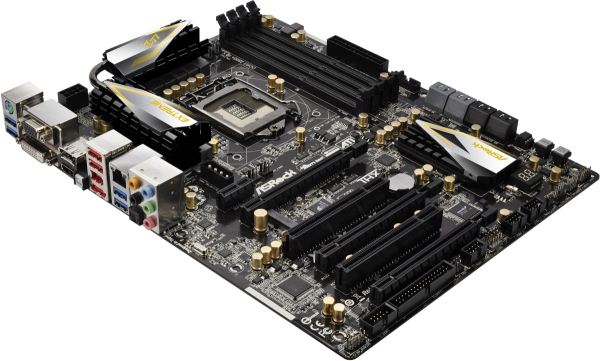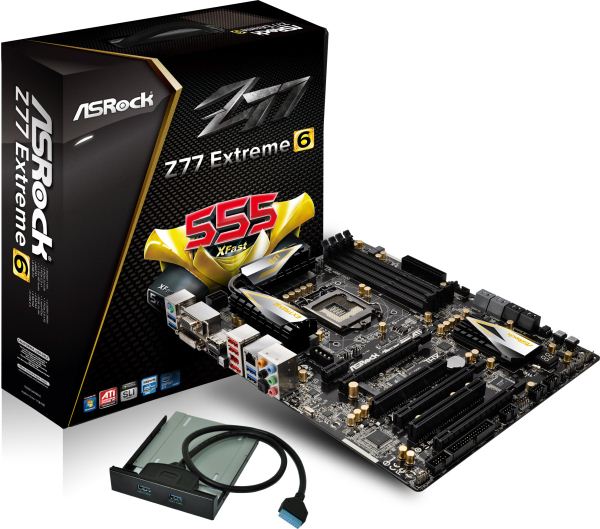ASRock Z77 Extreme6 Review: Legacy Bites Back
by Ian Cutress on July 13, 2012 2:00 PM EST- Posted in
- Motherboards
- ASRock
- Z77
The ASRock Z77 Extreme6 looks like a good motherboard on paper. If we do direct comparisons to the Z77 Extreme4, we have more substantial heatsinks, a floppy port, the full array of video outputs and a third PCIe slot at the bottom powered from the chipset.
The board itself is slightly bigger than the Extreme4, because the Extreme4 was actually smaller-than-ATX. However, the extra real estate is costing another $35, and we are not getting anything in the way of performance that excels. A quick glance over our benchmark suite and you will notice that the Z77 Extreme6 just does not light up the charts. It is usually in the middle of the road, of even worse, at the bottom.
The main thing the Z77 Extreme6 has going for it is the overclocking. All of the auto overclocking options worked first time, and plugging in my normal overclocking technique gives us some of the best results we have ever had for 4.7 GHz. Nevertheless, I did experience issues in getting my memory kit (G.Skill DDR3-2400 9-11-11) to work properly at XMP. Another plus side is that we get that awesome USB 3.0 front bracket in the box which doubles as an SSD holder.
Software wise, we do get a nice selection of network management software as well as RAM-Disk tools for temporary files. The software needs to be all bundled together as much as possible to feel more streamlined to users, as well as pulling some of the features in the BIOS (Dehumidifier, Online Management Guard) out into the software.
The BIOS is well built and laid out appropriately. There is room to move with regards how graphical BIOS can capture the imagination of the artist, and I am told we should expect something better for the later chipsets due out this year.
Simply put, some motherboards are a joy to work with. Every corner you turn they give you a little bit more. Even if the differences to other motherboards are minor, often a little spark improves your experience. ASRock ideas such as Internet Flash and OMG are good, but their implementation needs to be refined. ASRock are on the road to becoming one of the top tier manufacturers and joining the ranks of ASUS and Gigabyte, but the Z77 Extreme6 is not it. It gives you a nice overclock that removes the performance issues at stock speeds, but I cannot find much to get excited about.












35 Comments
View All Comments
nubie - Saturday, July 14, 2012 - link
Yes, a COM port and Serial port are generally the same thing.I much prefer Parallel, because I am "bit-banging" to program an Atmega micro-controller, a I2C EEPROM, or an SPI EEPROM.
Although I do have a couple Packard Bell Fast Media Infrared (FMIR) receivers that demand a COM port, as does the (sadly lacking drivers newer than Win98) 6-axis Spacetec Orb controller.
Meaker10 - Saturday, July 14, 2012 - link
Without looking at the specs the mini slot is pci-e (for wifi) as it is half height and msata slots need to be full height.repoman27 - Saturday, July 14, 2012 - link
I thought one of the features of the Z77 chipset was that you could select between 1 x16, 2 x8, or 1 x8 + 2 x4 for the PCIe 3.0 lanes coming off of the CPU? In which case you wouldn't need an additional PCIe switch and all three cards would get at least 32 Gbps of PCIe bandwidth...Also, Ian, you seem to have some persistent dyslexia going on when it comes to the model names of PLX's PCIe switches; it's "PEX 8747", not "PXE 8747". There are other options available as well, such as the smaller, cheaper PEX 8724, which would have allowed them to offer effectively 3 x8 PCIe 3.0 slots.
scott967a - Saturday, July 14, 2012 - link
Do you guys ever test wake on lan or other wake up functions? Reason being for the first time I thought I would set up an old sys using Abit P35 Pro for WoL with fail result. Not sure if it is operator error or MB/BIOS problem but searching online doesn't yield much info on WoL performance.529th - Sunday, July 15, 2012 - link
Thank you for including a DPC latency test. Thank you Thank you Thank you! ha...Which app are you using to check DPC latency, btw?
Please include DCP latency testings in your future Motherboard testings as well. I will be jumping on the Haswell wagon when it comes through town.
Cheers
529th - Sunday, July 15, 2012 - link
And also include the BIOS that it's being tested on. Thanks :)IanCutress - Sunday, July 15, 2012 - link
As you can perhaps tell from our DPC Graph, we've been testing it quite a while. And in the explanation of said test, I do mention the program I use - DPC Latency Checker. Quick Google will find it. Currently I'm rarely finding a motherboard on a mainstream chipset that severely fails it - usually it is the included monitoring software that causes peaks of 2000+. If this happens, disable your monitoring software or update the BIOS.Ian
hansmuff - Sunday, July 15, 2012 - link
If I were to release a legacy connector board, I would most certainly at the very least have two serial ports in the back, or one plus header. I would also most certainly include a parallel port header on the motherboard, and include brackets for serial and parallel headers.Floppy and IDE is all good and well, but one serial port and no parallel port are oversights to me for such a board.
adrianlegg - Monday, July 16, 2012 - link
Hello,I just had some random idea,
Couldn't You use, some kind of electric stopwatch, which can be started/paused with any current, connect it to poweron wire (from button), and then instead of using Windows, use some custom linux bootloader with option to, for example, use pc speaker, which signal would be used to stop mobo?
I lack proper knowledge to design that system, aside from components (2 wires, custom bootloader, and stopwatch/some multimeter with time option)
Excuse me if that's completely ignorant, but I think that could increase precision of Your timings.
Thx for all good work.
adrianlegg - Monday, July 16, 2012 - link
(ofc not "stop mobo" but "stop timing")